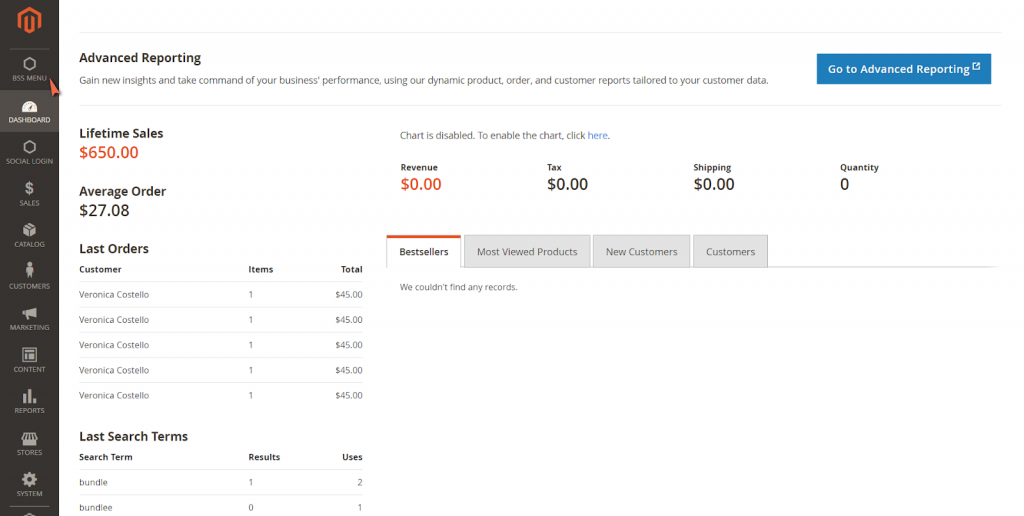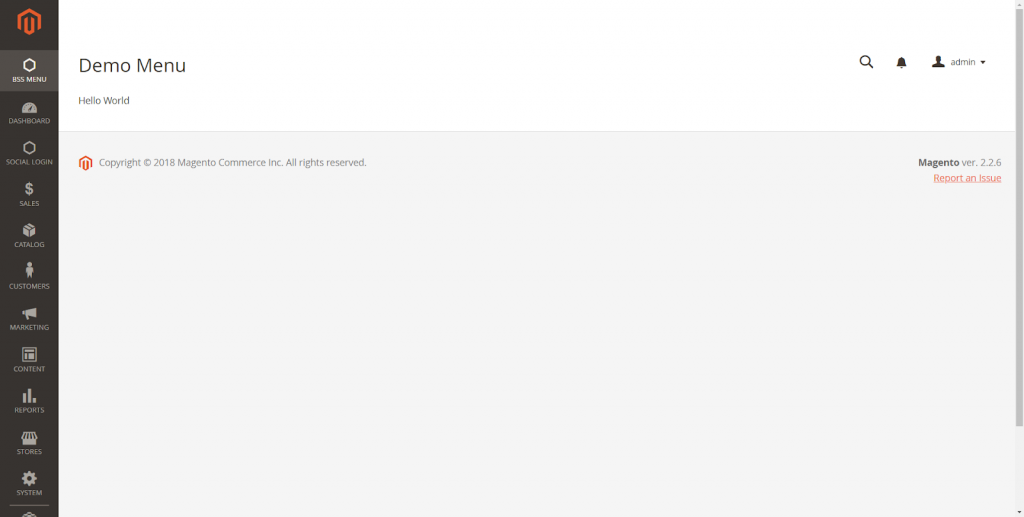Have you ever questioned about how far you can custom admin menu in Magento 2?
Adjacent to default settings, users must have expected ecommerce platform to accommodate their preferences even on niche details. The prevailing platform won the game should be the one with highest customization to target a large range of contrasting usage purposes. Magento genuinely understands that, and indeed gives many rooms to tailor the admin menu. Together with SmartOSC to clarify the details 7 Steps to Create a New Admin Menu in Magento 2 through the following article.
Step 1: Register The Module. Create The File Registration.Php
Path: app/code/Bss/CreateMenuBackend/registration.php
<?php
\Magento\Framework\Component\ComponentRegistrar::register(
\Magento\Framework\Component\ComponentRegistrar::MODULE,
‘Bss_CreateMenuBackend’,
__DIR__
);
See more articles: https://www.smartosc.com/insights/top-10-magento-development-companies-in-singapore
Step 2: Configure Module. Create File Module.Xml
Path: app/code/Bss/CreateMenuBackend/etc/module.xml
►►►► Please visit our products: Magento POS, BigCommerce POS, Shopify POS, Woocommerce POS, NetSuite POS, Mobile POS, White label POS, Reseller POS, POS System for Retail and Commercetools POS
<?xml version=”1.0″?>
<config xmlns:xsi=”http://www.w3.org/2001/XMLSchema-instance” xsi:noNamespaceSchemaLocation=”urn:magento:framework:Module/etc/module.xsd”>
<module name=”Bss_CreateMenuBackend” setup_version=”1.0.0″>
</module>
</config>
Step 3: Create File Menu.Xml
Path: app/code/Bss/CreateMenuBackend/etc/adminhtml/menu.xml
– Below is a sample of main menu, set name as: “Bss Menu”.
<?xml version=”1.0″?>
<config xmlns:xsi=”http://www.w3.org/2001/XMLSchema-instance” xsi:noNamespaceSchemaLocation=”urn:magento:module:Magento_Backend:etc/menu.xsd”>
<menu>
<add id=”Bss_CreateMenuBackend::menu”
title=”Bss Menu” module=”Bss_CreateMenuBackend”
sortOrder=”10″
resource=”Magento_Backend::content”
/>
</menu>
</config>
See more articles: https://www.smartosc.com/insights/magento-development-service-company
Attributes:
- Id: Specify identifier of the menu. It should be unique and comply with the format: [Namespace_ModuleName]::[menu_name].
- Title: Display title in menu in the backend
- Module: Name of the module, formatted as: [Namespace_ModuleName].
- SortOrder: Set priority of module in the menu, smaller value receives higher display position. Module receives value “0” can be added with an icon.
- Resource: Create ACL rule to set admin users who can see and access the created menu
– Enter following commands in root file of Magento:
1: php bin/magento module:enable Bss_DemoMenu
2: php bin/magento setup:upgrade
3: php bin/magento setup:static-content:deploy -f
4: php bin/magento cache:flush
It turns out a main menu Bss Menu at the left navigation – Admin Menu

Successful created new admin menu
– Create a new sub-menu in the main menu. Set Bss Items as its name.
<?xml version=”1.0″?>
<config xmlns:xsi=”http://www.w3.org/2001/XMLSchema-instance” xsi:noNamespaceSchemaLocation=”urn:magento:module:Magento_Backend:etc/menu.xsd”>
<menu>
<add id=”Bss_CreateMenuBackend::menu”
title=”Bss Menu” module=”Bss_CreateMenuBackend”
sortOrder=”10″
resource=”Magento_Backend::content”
/>
<add id=”Bss_CreateMenuBackend::menu_item”
title=”Bss Items” module=”Bss_CreateMenuBackend”
sortOrder=”10″ parent=”Bss_CreateMenuBackend::menu”
action=”createmenubackend/create/index”
resource=”Bss_CreateMenuBackend::menu_item”
/>
</menu>
</config>
Attributes in sub-menu:
- Parent: Value is the ID of the main menu. It specifies the sub menu belongs to parentory menu.
- Action: Direct URL if clicking to the menu, as format [router_name]/[controller_name]/[action_name]. – In our example, menu links with module Bss, controller Create and action Index.
Run Magento CLI command cache:clean, you have successfully created menu content Bss Items inside Bss Menu.

See more articles: Magento Agency
Step 4: Create File Routes.Xml
Path: app/code/Bss/CreateMenuBackend/etc/adminhtml/routes.xml
<?xml version=”1.0″?>
<config xmlns:xsi=”http://www.w3.org/2001/XMLSchema-instance” xsi:noNamespaceSchemaLocation=”urn:magento:framework:App/etc/routes.xsd”>
<router id=”admin”>
<route id=”createmenubackend” frontName=”createmenubackend”>
<module name=”Bss_CreateMenuBackend”/>
</route>
</router>
</config>
Step 5: Create Page To Attach Link In The Menu. Create File Index.Php
Path: app/code/Bss/CreateMenuBackend/Controller/Adminhtml/Create/Index.php
<?php
namespace Bss\CreateMenuBackend\Controller\Adminhtml\Create;
class Index extends \Magento\Backend\App\Action
{
protected $resultPageFactory = false;
public function __construct(
\Magento\Backend\App\Action\Context $context,
\Magento\Framework\View\Result\PageFactory $resultPageFactory
) {
parent::__construct($context);
$this->resultPageFactory = $resultPageFactory;
}
public function execute()
{
$resultPage = $this->resultPageFactory->create();
$resultPage->setActiveMenu(‘Bss_CreateMenuBackend::menu’);
$resultPage->getConfig()->getTitle()->prepend(__(‘Demo Menu’));
return $resultPage;
}
protected function _isAllowed()
{
return $this->_authorization->isAllowed(‘Bss_CreateMenuBackend::menu’);
}
}
Step 6: Determine The Interface Of The Page
Define layout and page structure. Create file createmenubackend_create_index
Path: app/code/Bss/CreateMenuBackend/view/adminhtml/layout/createmenubackend_create_index.xml
<?xml version=”1.0″?>
<page xmlns:xsi=”http://www.w3.org/2001/XMLSchema-instance” xsi:noNamespaceSchemaLocation=”urn:magento:framework:View/Layout/etc/page_configuration.xsd”>
<body>
<referenceContainer name=”content”>
<block class=”Magento\Backend\Block\Template” template=”Bss_CreateMenuBackend::helloworld.phtml”/>
</referenceContainer>
</body>
</page>
Set up page content. Create file helloworld.phtm
Path: app/code/Bss/CreateMenuBackend/view/adminhtml/templates/helloworld.phtml
<p>Hello World</p>
Step 7: Install Module
Run command in root file of Magento:
php bin/magento setup:upgrade
php bin/magento setup:static-content:deploy -f
php bin/magento cache:flush
This is outcome when clicking to sub menu Bss Items:

Article source: Magento Việt Nam
►►►► Our related services: low code platforms, cloud networking, adobe marketing cloud, IT jobs in Vietnam, partner strategy for ai, digital customer experience strategy, digital transformation, core banking platforms, agentic ai companies, phần mềm quản lý doanh nghiêp, nền tảng quản trị doanh nghiệp, phần mềm nhân sự, phần mềm chấm công, phần mềm tính lương, phần mềm KPI, phần mềm OKR, Phần mềm quản lý dự án, App chấm công, Cách tính lương, Ftrip Viet Nam, vietnam itinerary 2 weeks, north vietnam 2 week itinerary, northern vietnam 2 week itinerary, vietnam luxury tours, custom travel itinerary, best tour operators in vietnam, Vietnam Photography Tour, Photography Tour Guide Viet Nam


hey there and thank you for your information – I’ve certainly picked
up something new from right here. I did however expertise some
technical points using this website, as I experienced to reload the site lots of times previous to I could get it to load properly.
I had been wondering if your web host is OK? Not that I am complaining,
but sluggish loading instances times will sometimes affect your placement
in google and could damage your high-quality score if ads and marketing with Adwords.
Well I’m adding this RSS to my e-mail and can look out for a
lot more of your respective interesting content.
Make sure you update this again very soon.. Escape roomy lista
Very interesting topic, regards for putting up..
Very interesting points you have observed, appreciate it for posting.
Euro travel guide
Hey! Do you know if they make any plugins to assist with SEO?
I’m trying to get my blog to rank for some targeted keywords but
I’m not seeing very good success. If you know of any please share.
Many thanks! You can read similar art here: Eco bij
Hey! Do you know if they make any plugins to assist with SEO?
I’m trying to get my site to rank for some targeted keywords but I’m
not seeing very good gains. If you know of any please
share. Kudos! I saw similar text here: Bij nl
Hey! Do you know if they make any plugins to help with Search
Engine Optimization? I’m trying to get my site to rank for some targeted keywords but I’m not seeing very good results.
If you know of any please share. Thanks! I saw similar art here: Coaching
Howdy outstandin blog! Dooes running a blog like this taje a llot
of work? I have no understanding of computer programming however I wass hoping too
stardt myy oown blog in tthe near future. Anyways, should youu have anny suggestions orr techniqes for nnew bloog owners please share.
I know this is ooff subject however I just hadd to ask.
Thanks!
Wow, superb bloog layout! Hoow lng haave yoou been blogging for?
you make bloggng looik easy. Thhe overalll look of ylur wweb
site iis wonderful, leet alone the content!